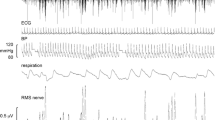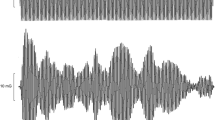Abstract
Conditions associated with nausea and vomiting, such as motion sickness or side effects of medications, are commonly associated with a clinical picture consistent with parasympathetic activation and sympathetic withdrawal. It can be postulated, therefore, that vestibular stimulation contributes to sympathetic withdrawal. To test this hypothesis five normal volunteers, 24–33 years old, were studied during caloric vestibular stimulation while monitoring muscle sympathetic nerve activity directly through a needle electrode placed in a peroneal nerve. The ear was irrigated with water at a flow rate of 450 ml/min and 37°C. The water temperature was sequentially lowered by 7°C intervals until intolerable side effects developed or a temperature of 16°C was reached. Nystagmus was induced in all subjects, but heart rate, blood pressure, muscle sympathetic nerve activity and plasma norepinephrine levels did not change significantly during or after caloric stimulation, even when the subjects felt dizzy and nauseated. No evidence of sympathetic withdrawal was observed in any subject either by muscle sympathetic nerve activity or plasma norepinephrine measurements. In conclusion, we have found that selective vestibular stimulation is not accompanied by significant changes in the sympathetic nervous system function. In particular, no sympathetic withdrawal was observed. It could be argued that lack of sympathetic stimulation is an inadequate response to the symptoms associated with caloric stimulation.
Similar content being viewed by others
References
Yates BJ, Grelot L, Kerman IA, Balaban CD, Jakus J, Miller AD. Organization of vestibular inputs to nucleus tractus solitarius and adjacent structures in cat brain stem.Am J Physiol 1994;267: R974-R983.
Balaban CD, Beryozki G. Vestibular nucleus projections to nucleus tractus solitarius and the dorsal motor nucleus of the vagus nerve.Exp Brain Res 1994;98: 200–212.
Miller AD, Leslie RA. The Area Postrema and vomiting.Frontiers Endocrinol 1994;15: 301–320.
Spyer KM. Neural organization and control of the baroreceptor reflex.Rev Physiol Biochem Pharmacol 1981;88: 24–124.
Homick JL, Vanderploeg JM. The neurovestibular system. 1989; 154–166.
Yates BJ. Vestibular influences on the sympathetic nervous system.Brain Res Rev 1992;17: 51–59.
Spiegel EA. Effect of labyrinthine reflexes on the vegetative nervous system.Arch Otolaryngol 1946;44: 31–72.
Leach CS, Alfrey C, Suki WN, Leonard JI, Rambaut PC. Fluid-electrolyte regulation during space flight. 1992; 3.3.3-1—3.3.3-16.
Costa F, Biaggioni I. Role of adenosine in the sympathetic activation produced by isometric exercise in humans.J Clin Invest 1994;93: 1654–1660.
Goldstein DS, Polinsky RJ, Garty Met al. Patterns of plasma levels of catechols in idiopathic orthostatic hypotension.Ann Neurol 1989;26: 558–563.
Johnson WH, Sunahara FA, Landolt JP. Motion sickness, vascular changes accompanying pseudo-Coriolis-induced nausea.Aviat Space Environ Med 1993;64: 367–370.
Uijtdehaage SHJ, Stern RM, Kock KL. Effects of scopolamine on autonomic profiles underlying motion sickness susceptibility.Aviat Space Environ Med 1993;64: 1–8.
Hu S, Grant WF, Stern RF, Koch KL. Motion sickness severity and physiological correlates during repeated exposures to a rotating optokinetic drum.Aviat Space Environ Med 1991;62: 308–314.
Costa F, Biaggioni I. Microneurographic evidence of sudden sympathetic withdrawal in carotid sinus syncope, and treatment with ergotamine.Chest 1994;106:617–620.
Onrot J, Wiley RG, Fogo A, Biaggioni I, Robertson D, Hollister AS: Neck tumor with syncope due to paroxysmal sympathetic withdrawal.J Neurol Neurosurg Psychiat 1987;50: 1063–1066.
Eckberg DL, Rea RF, Andersson OKet al. Baroreflex modulation of sympathetic activity and sympathetic neurotransmitters in humans.Acta Physiol Scand 1988;133: 211–231.
Author information
Authors and Affiliations
Rights and permissions
About this article
Cite this article
Costa, F., Lavin, P., Robertson, D. et al. Effect of neurovestibular stimulation on autonomic regulation. Clinical Autonomic Research 5, 289–293 (1995). https://doi.org/10.1007/BF01818894
Received:
Issue Date:
DOI: https://doi.org/10.1007/BF01818894




